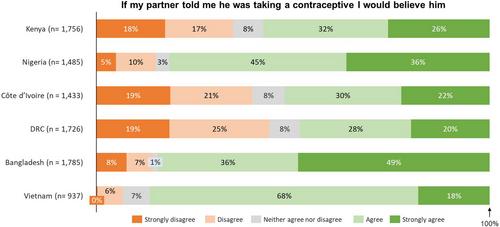Assessment of demand for male contraceptives: A multi-country study
Abstract
Background
As of 2019, high unmet contraceptive needs in low- and middle-income countries result in nearly half of all pregnancies being unintended. Additional male contraceptive options could help, but gaps remain in assessing demand for them. As the development of novel male contraceptives progresses, addressing these gaps would help inform policy and scientific direction.
Objectives
Measure consumer demand for novel male contraceptives and identify product attributes associated with men's preferences.
Materials & methods
A cross-sectional, probability-based-sample survey was conducted with 12,435 sexually active, fertile cisgender, heterosexual men aged 18–60 years, and 9,122 of their female partners in Bangladesh, Vietnam, Kenya, Nigeria, DR Congo, and Côte d'Ivoire from May 2021 to October 2022. The survey was also conducted in the United States among 3,243 of these men in April 2022. A follow-up with 3,070 men in May 2023 assessed potential changes in demand after the Supreme Court's Dobbs v. Jackson Women's Health Organization decision. The surveys assessed contraceptive use, perceptions, and sociodemographic characteristics, and a discrete choice experiment evaluated preferences for 11 potential product attributes. Data from female partners in the six LMICs indicated their interest and trust in male partners’ contraceptive use.
Results
On average, 61% of men showed interest in trying novel male contraceptives in their first year of availability, ranging from 39% and 49% (pre- and post-Dobbs) in the United States to 76% in Nigeria and Bangladesh. Form of administration and time of use drove men's product preferences. Female partners’ interest and trust in male contraceptive use were high across geographies.
Discussion
This study reveals strong latent demand for novel male contraceptives, highlighting the potential for novel male methods to meet unmet needs, and female partners’ trust in men to use them.
Conclusion
High demand for novel male contraceptives among men and their partners exists, supporting investment in their development.


 求助内容:
求助内容: 应助结果提醒方式:
应助结果提醒方式:


